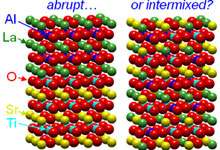Complex oxide interfaces are more complex than previously thought

Using experimental resources at EMSL, scientists from the Pacific Northwest National Laboratory and University College London have shown that intermixing occurs at the interface of two perovskites – lanthanum aluminate and strontium titanate – for a range of compositions. Intermixing is of interest because this interface is conductive when prepared under certain conditions, and atom positions at the interface influence the electronic structure.
When scientists first began measuring interfacial conductivity, they developed a two-dimensional model that hypothesizes an electronic reconstruction at the interface triggered by growing a polar perovskite on a nonpolar perovskite with little or no intermixing as the cause of conductivity. Achieving conductivity at such interfaces could have positive repercussions for developing next-generation electronics.
Having studied other samples for a long time, the PNNL and UCL team designed and tested their own materials. They systematically showed that the interfacial mixing occurs over a range of stoiochiometries to a greater extent than previously thought.
The team conducted this research using pulsed laser deposition to create thin layers of lanthanum aluminate and strontium titanate. The deposited layers were on the order of 2 nanometers, or 8 atomic layers, thick. This depth was chosen because it is the minimum depth needed to achieve conductivity. Next, the team examined the materials they created using in situ angle-resolved x-ray photoelectron spectroscopy. The study revealed that rather extensive intermixing of the aluminum, lanthanum, strontium, and titanium ions occurs at the interface for all of the films investigated. These results were at odds with the simple models of quasi-abrupt interface formation.
More information: Qiao L, et al. 2011. “Cation Mixing, Band Offsets and Electric Fields at LaAlO3/SrTiO3(001) Heterojunctions with Variable La:Al Atom Ratio.” Surface Science 605:1381-1387.
Provided by Environmental Molecular Sciences Laboratory



















